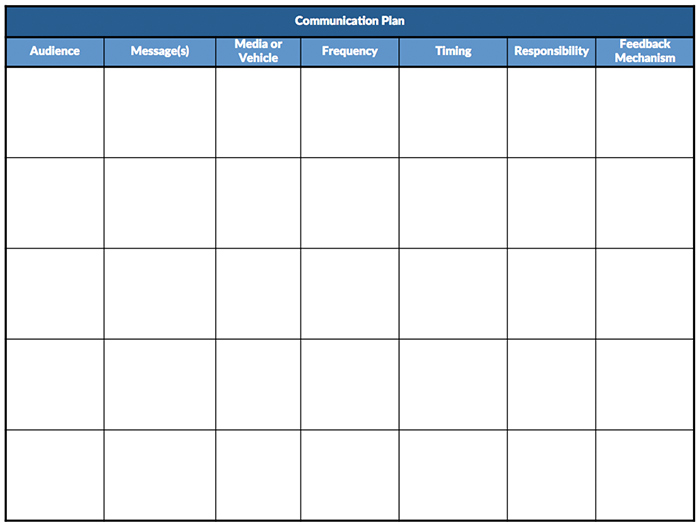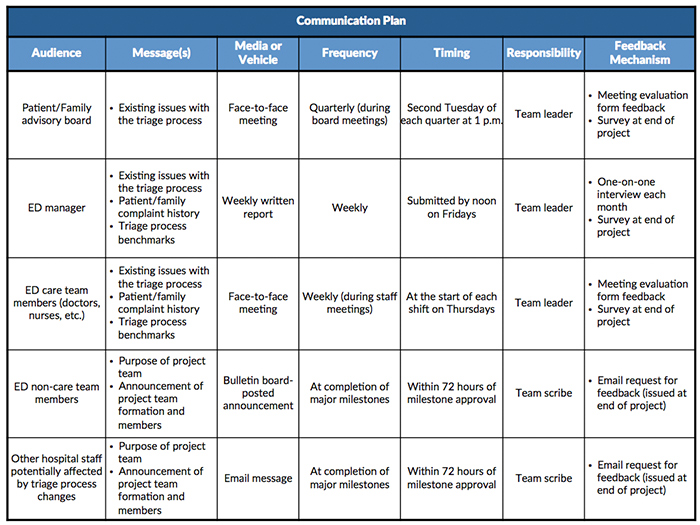Reaching People Effectively: Communication Plans
By Deborah Hopen
On any project, teams need to make sure they are keeping key people informed. This helps head off resistance and increase commitment to your effort. A communication plan is a tool that helps team members outline important details, such as who you will communicate to, what the message is and the frequency of communication.
People who have an investment or interest in your project are your “stakeholders.” Once you understand their perceptions and influence—through a stakeholder analysis—you can take steps to build support and reduce any resistance. This is where the communication plan comes in. Such a plan provides a fairly detailed, but easy-to-follow, summary for ensuring people receive appropriate information about the project.
A communication plan is a good tool for teams to use early in their projects to establish an initial approach for communicating with key stakeholders. Much of the thinking that goes into the initial plan will remain applicable throughout the project, but some things may shift as your project progresses. The plan can also be used as a checklist to ensure actions are being carried out and as a handy reminder for teams about the importance of communicating effectively with your stakeholders.
What’s In a Communication Plan?
When developing a communication plan, there are several areas you’ll want to consider:
Audience—Each person or group who will receive messages should be listed in a separate row in the communication plan. All of your stakeholders will be listed, as well as any others who need to be kept informed. Team members should not be listed here as they will be responsible for disseminating the messages. It’s unusual for the originally identified audience to change substantially during the project, so thoughtful consideration of who should receive communications is necessary at the project onset.
The information communicated to the audience members and groups should be based on their specific needs and expectations.
Message(s)—The information communicated to the audience members and groups should be based on their specific needs and expectations. The content of the messages is likely to vary quite a bit during different phases of the project. For instance, the rationale supporting the initiative is often part of the first communication. It may be mentioned briefly in latter messages, but is unlikely to remain the key focus. As the project proceeds, the messages tend to focus more on progress, specific findings and results, and issues and resolutions that have developed. At the end, a summary of the final project results and any future recommended actions is most common.
Media or Vehicle—There are many ways to deliver messages and selecting the most appropriate option depends on several factors. For example, the decision of whether to use face-to-face communication or an email message would be based on proximity of team members to the stakeholder and the level of detail the stakeholder needs to remain engaged. To make the best choice of vehicle, you’ll want to consider a combination of elements that can impact preferences, including the communicator’s skills.
Frequency—A good guide for frequency is to provide updates at the start and end of the project, as well as at the completion of each major milestone or phase. Complex analyses and new findings may require special communications. This will give stakeholders the opportunity to digest and become comfortable with information that diverges from historically accepted premises or approaches.
Timing—Care should be taken to schedule communications for times that are amenable to the audience members. There is little to gain by cornering a key stakeholder, even if the team member believes the message is urgent. For some communications—most frequently those associated with regularly released data—a particular date or time period may be most appropriate for sharing the information.
Responsibility—One or more team members should be assigned with ensuring that the communications for a particular audience member are carried out as intended. Don’t count on this plan happening properly if accountability has not been established.
Feedback Mechanism—Communication is a two-way process that works most effectively when both senders and receivers can reverse roles at times. Techniques such as active listening, asking check-in questions, and paraphrasing can be used to obtain instant feedback. Other methods are more valuable for identifying systematic communication issues and guiding improvements in the communication plan. These include surveys, focus groups and individual interviews. For a short project, there may be only one application of a more in-depth method, but during longer project, intermediate evaluations can be conducted at multiple points.

Steps to Fill Out the Communication Plan
- First, using the template provided above, list all audience members—whether an individual or group—in the left column. Each different audience member should be entered in a separate row.
- Determine what message(s) need to be communicated. Identify the necessary level of detail and any supporting tables, graphs or other illustrations that should be included to clarify the information. Enter brief notes that summarize the message(s) in the appropriate column.
- Consider the options for media/vehicle, frequency, timing and feedback mechanism. Select the best combination that will meet both each stakeholder’s and the team’s needs.
- Indicate the team member(s) charged to oversee implementation of the plan for each stakeholder.
- Add a footnote to the bottom of the document that indicates the date of its creation and the name of one or more participants who can be contacted if additional information is needed. This is a good general practice when creating any project documentation.
Example of a Completed Communication Plan
The figure below shows an example of a communication plan for a project involving a hospital’s emergency department (ED). The team has been assigned to improve the triage process so that patients can receive needed care in the most time-sensitive order. This is a first version of the plan, created at the beginning of the project. The elements address the specific effect the project results will have on the audience member and the level of engagement the team needs from that person or group. These two factors dominate the choices made for many of the plan components.

When developing a communication plan, remember that stakeholders who are not involved directly in team meetings and decisions are more likely to be concerned about impending changes. Providing appropriately detailed information on a regular basis can build commitment and reduce resistance.
A Coach’s Perspective
Many teams do not invest the time and effort required to alter the communication plan to meet the unique needs and expectations of the audience members. This creates a higher potential that the intended messages will not be understood clearly or will not generate the desired responses from the stakeholders.
When the communication plan does not reflect a thorough grasp of the stakeholders’ perspectives and situations, rumors and misinformation often abound.”
In fact, when the communication plan does not reflect a thorough grasp of the stakeholders’ perspectives and situations, rumors and misinformation often abound, and these can dramatically undermine the project’s success. Spending just a few more minutes in consideration of each audience member’s perspective can be extremely valuable.
Check Your Understanding
Here are some questions for you to consider regarding the use of the communication plan. They provide a way for you to quickly evaluate your understanding.
- How can you determine the factors that might affect the best communication approaches for each audience member?
- Suppose you were trying to communicate the rationale supporting your project to a diverse cross-section of stakeholders. What could you do to ensure that they each understood the situation completely, despite their differing backgrounds and perspectives?
- What other tools can you use to ensure your communication plan is implemented as intended
- How would you summarize the information obtained and work with your team to improve its communication process?
Deborah Hopen has over 40 years of experience in total quality management, and has served as a senior executive with both Fortune and Inc. 500 companies. She is a Fellow of the American Society for Quality and is the editor of ASQ’s Journal for Quality and Participation.

